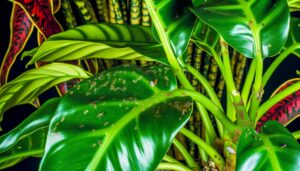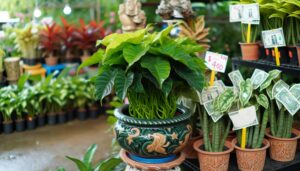What Is a Leaf Node on a Philodendron Selloum?
A leaf node on a Philodendron Selloum, scientifically known as Thaumatophyllum bipinnatifidum, is a swelling on the stem where leaves, buds, and aerial roots originate. These nodes are essential for the distribution of nutrients and contain meristematic tissue critical for growth.
They can be identified by the emergence of petioles and various intervals along the stem. Leaf nodes also play a significant role in vegetative propagation, aiding in the development of adventitious roots.
Proper care, such as bright indirect sunlight and balanced fertilization, guarantees the health of these nodes. For a deeper understanding of their importance and care, continue.
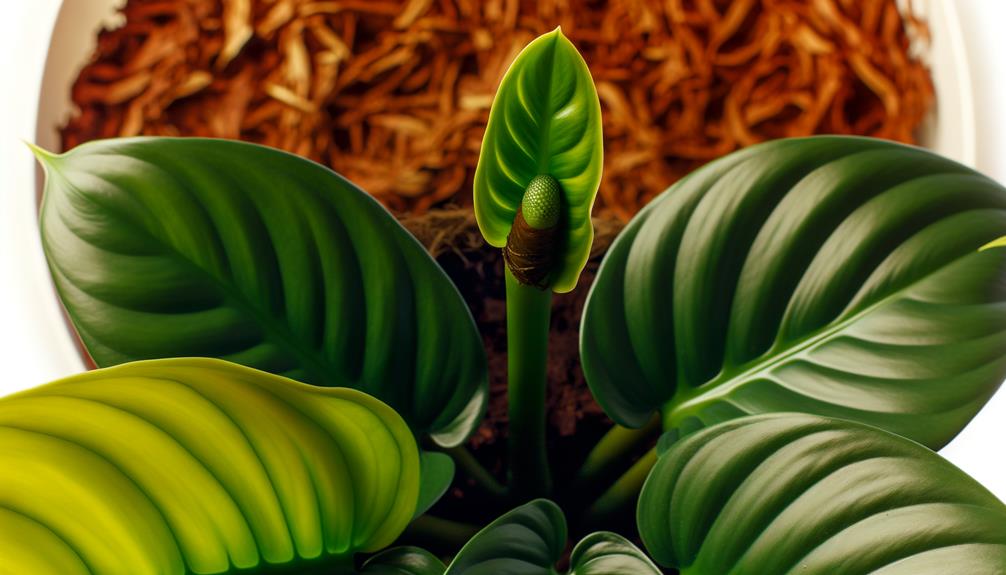
Key Takeaways
- Leaf nodes are swellings on the stem where leaves, branches, or buds originate.
- They contain meristematic tissue crucial for plant growth and development.
- Leaf nodes can be identified by the emergence of petioles and aerial roots.
- Nodes are essential for nutrient distribution and support vegetative propagation.
- Healthy nodes are vital for the development of adventitious roots and new growth.
Definition of a Leaf Node
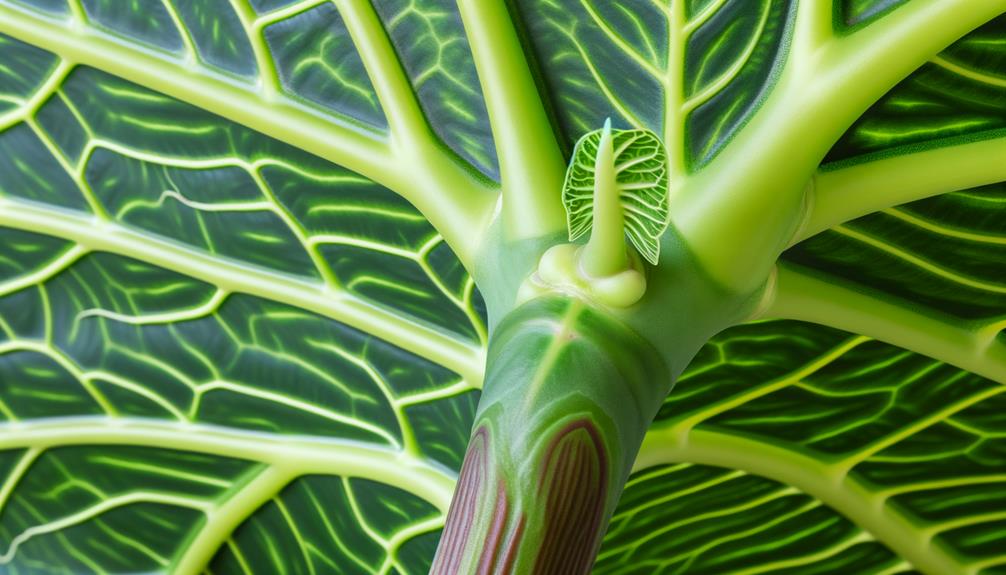
A leaf node, in botanical terms, refers to the specific location on a stem where a leaf or bud is attached, playing an important role in the plant's growth and development.
In Philodendron selloum, also known as Thaumatophyllum bipinnatifidum, the leaf node is a crucial anatomical feature. This node contains meristematic tissue, which actively divides to facilitate the formation of new leaves and stems.
The presence of nodes enables the plant to respond to environmental stimuli and optimize photosynthetic efficiency. Additionally, these nodal regions house vascular bundles, consisting of xylem and phloem, which are essential for the transport of water, nutrients, and photosynthates.
Understanding the function and structure of leaf nodes is crucial for horticultural practices and plant physiology studies.
Identifying Leaf Nodes
Identifying leaf nodes on Philodendron selloum involves examining the stem for distinct swellings or joints where petioles emerge and small buds may be present. These nodes are essential for recognizing potential sites of new growth or propagation. The nodes appear as slightly enlarged areas along the stem, often accompanied by aerial roots.
| Characteristic | Description | Example |
|---|---|---|
| Swellings | Enlarged sections of the stem | Visible bulges |
| Petiole Emergence | Point where the leaf stalk attaches | Junction points |
| Presence of Buds | Small growths that may develop into new leaves | Buds or shoots |
| Aerial Roots | Roots emerging from the nodes | Roots above soil |
| Node Position | Located at intervals along the stem | Regular intervals |
Understanding these features helps in identifying leaf nodes accurately.
Significance for Plant Growth
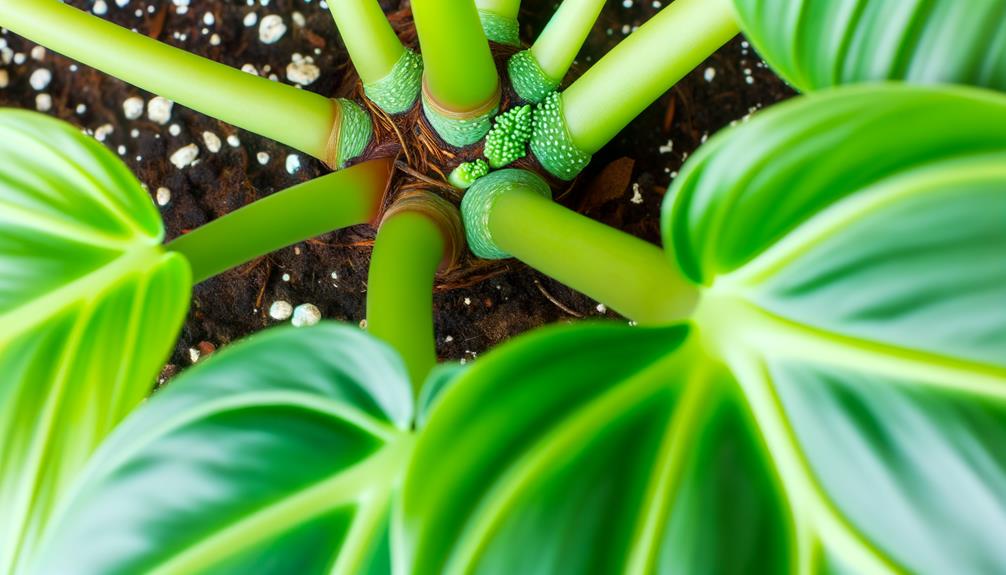
The leaf nodes of Philodendron selloum play an important role in the plant's overall growth by serving as crucial sites for necessary nutrient distribution and new leaf development.
These nodes facilitate the transport of water, minerals, and photosynthates through the vascular bundles, ensuring proper nourishment across the plant.
Additionally, meristematic tissues within the nodes initiate the formation of new leaves, contributing to the plant's expansion and health.
Essential Nutrient Distribution
Ensuring the best distribution of essential nutrients such as nitrogen, phosphorus, and potassium is essential for the robust growth and physiological functioning of Philodendron selloum.
Nitrogen (N) is fundamental for chlorophyll production and overall leaf vitality, enhancing photosynthesis.
Phosphorus (P) aids in the formation of ATP, vital for energy transfer and root development.
Potassium (K) regulates osmotic balance, assisting in water uptake and enzyme activation.
The vascular system, comprising xylem and phloem, plays a pivotal role in translocating these nutrients to various plant tissues, including leaf nodes.
Effective nutrient uptake and distribution foster cellular elongation and division, ultimately supporting the plant's structural integrity and growth.
Proper nutrient management is essential for achieving optimal physiological health in Philodendron selloum.
New Leaf Development
New leaf development in Philodendron selloum is an essential process that greatly influences overall plant growth, health, and morphological structure. The emergence of new leaves is facilitated by the activity of meristematic cells located at the apical bud. These cells undergo rapid mitotic division, contributing to the elongation and differentiation of the leaf primordia.
The newly developed leaves play a pivotal role in photosynthesis, increasing the plant's ability to convert light energy into chemical energy. This energy is then utilized for various physiological processes, including nutrient uptake and growth. Additionally, the expansion of leaf surface area enhances transpiration, aiding in nutrient transport and gas exchange.
Consequently, new leaf development is crucial for sustaining the robust growth and vitality of Philodendron selloum.
Role in Propagation
The leaf node, or internode region, on Philodendron selloum (syn. Thaumatophyllum bipinnatifidum) is essential for vegetative propagation, serving as the primary site for cutting and rooting.
This anatomical structure facilitates the development of adventitious roots, thereby promoting new growth and ensuring the successful establishment of propagated specimens.
Best selection of a robust leaf node, exhibiting active axillary bud development and minimal signs of senescence, is crucial for maximizing propagation success.
Cutting and Rooting
Taking cuttings from a Philodendron selloum (syn. Thaumatophyllum bipinnatifidum) involves selecting a healthy stem segment with at least one leaf node, which is crucial for successful propagation. The leaf node contains meristematic tissue capable of generating new roots and shoots. Cuttings should be made using sterile tools to prevent pathogen introduction. After cutting, the stem segment can be placed in water or a well-draining rooting medium. Proper humidity and temperature control expedite root formation. The table below outlines the key steps for cutting and rooting:
| Step | Description | Notes |
|---|---|---|
| 1. Selection | Choose a healthy stem with a node | Avoid damaged stems |
| 2. Sterilize | Use sanitized cutting tools | Prevents infection |
| 3. Cutting | Cut below the leaf node | Ensures node inclusion |
| 4. Placement | Place in water/medium | Guarantee good drainage |
| 5. Environment | Maintain humidity and warmth | Speeds up root development |
Promoting New Growth
Ensuring ideal conditions for new growth in Philodendron selloum propagation involves maintaining consistent moisture levels and providing sufficient light to stimulate photosynthetic activity in the developing shoots.
Proper hydration is vital, as the root system of Philodendron bipinnatifidum requires a balanced water supply to facilitate nutrient uptake. Adequate indirect sunlight is also essential, as it promotes chlorophyll production necessary for vigorous growth.
Humidity levels should be kept moderately high, ideally around 60-70%, to mimic the plant's native tropical habitat. Additionally, using a well-draining substrate rich in organic matter can enhance root development.
The presence of auxins, plant hormones that regulate growth, can further expedite the rooting process, making leaf nodes pivotal in successful asexual propagation.
Optimal Leaf Node Selection
Selecting the most suitable leaf node for propagation in *Philodendron selloum* involves identifying nodes with healthy, well-developed aerial roots and prominent bud sites, as these are key indicators of the node's potential to generate robust new growth.
Aerial roots, *radices aereae*, facilitate nutrient absorption and stabilize the cutting during initial establishment. Nodes lacking visible buds or with underdeveloped roots are less likely to thrive.
When choosing a node, inspect the internodal spacing to make sure it is neither excessively elongated nor overly compacted, as this affects the cutting's overall vigor. Ideal selection also takes into account the plant's age, with mature nodes generally showing higher propagation success rates.
Carefully excise the chosen node using sterilized tools to minimize pathogen transmission.
Common Issues With Leaf Nodes
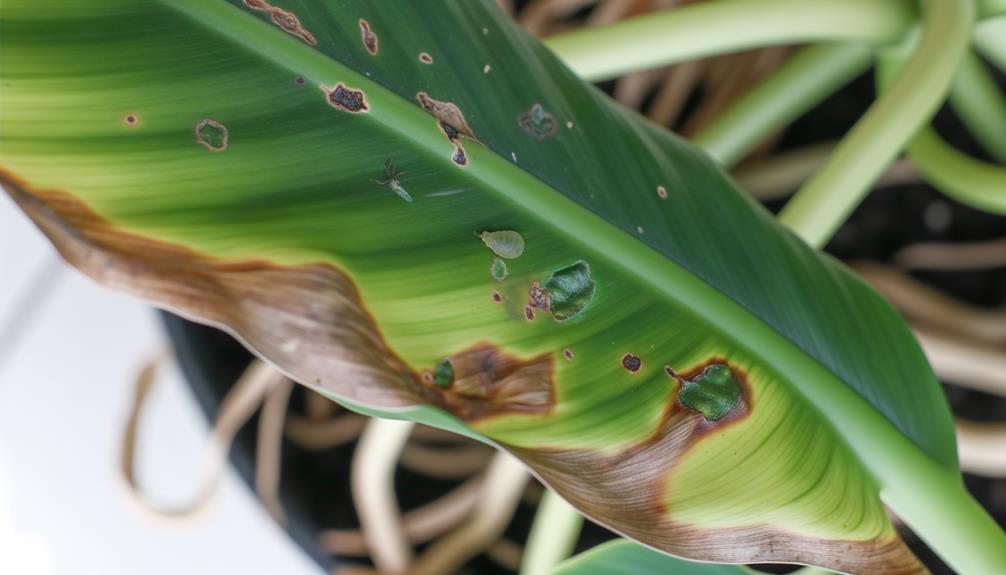
One prevalent issue with leaf nodes on Philodendron selloum, also known as Philodendron bipinnatifidum, is the occurrence of necrosis due to inadequate nutrient uptake. Nutrient deficiencies can compromise the plant's physiological functions, leading to the following issues:
- Chlorosis: A condition characterized by yellowing leaves, indicating a lack of chlorophyll due to insufficient nitrogen, iron, or magnesium.
- Stunted Growth: When nodes fail to elongate properly, resulting in smaller leaves and reduced overall plant vigor, often linked to phosphorus deficiency.
- Leaf Drop: Premature shedding of leaves may occur, commonly a result of potassium deficiency, which affects cellular functions and water regulation within the plant.
Understanding these issues is essential for diagnosing and addressing the underlying nutrient imbalances affecting Philodendron selloum.
Care Tips for Healthy Nodes
Maintaining healthy leaf nodes on Philodendron selloum requires providing ideal light conditions, appropriate watering practices, and a balanced nutrient regimen tailored to the plant's specific requirements.
Best light conditions involve bright, indirect sunlight, which promotes robust photosynthesis without causing photodamage.
Watering should be consistent yet moderate; the soil must remain slightly moist but not waterlogged to prevent root rot and promote healthy growth at the nodes. A well-draining soil mix, rich in organic matter, is essential.
Fertilization with a balanced, water-soluble fertilizer (e.g., 20-20-20 N-P-K ratio) every 4-6 weeks during the growing season supports nutrient uptake, fostering vigorous nodal development.
Regular inspection for pests and diseases is also essential to maintain node health and overall plant vitality.
Conclusion
To conclude, leaf nodes on Philodendron selloum, scientifically referred to as Thaumatophyllum bipinnatifidum, act as crucial points for nutrient exchange, growth, and propagation.
Correct identification and care of these nodes guarantee strong plant development and successful vegetative propagation.
Disregarding these vital parts can result in limited growth and propagation setbacks.
Ultimately, preserving healthy leaf nodes is the essential factor in revealing the plant's complete capacity, showing that focusing on specifics can determine the success or failure of cultivation.




